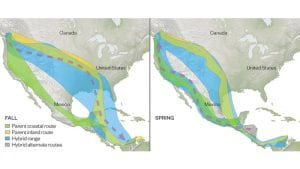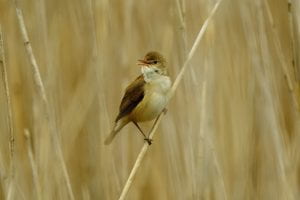This post was written by ScIU Undergraduate Intern Savannah Ahmad.
Every year, the skies come alive as billions of birds begin their migration. From the Arctic Tern, with its remarkable marathon around the Earth to the quaint journey of the Dusky Grouse, the avian spectrum is a captivating display of nature’s variability. How do these travelers embark on such extraordinary journeys, navigating through continents and oceans with such precision? The secret lies in their ability to sense Earth’s magnetic field (magnetoreception) and their use of celestial patterns (stars position, sun position, and skylight polarization) as guiding tools.
The “clock gene”
What drives birds to undertake these journeys and how do they know where to go? The contention regarding migration patterns as an inherited or learned behavior has been an enduring topic of discussion. A study by the University of British Columbia, headed by PhD student Kira Delmore, suggested that songbirds might be the key to unlocking the mystery behind these migratory functions. Starting in Canada, Swainson thrush, a boreal songbird, generally takes one of two distinct paths, one moving from northwest to southwest along the California coast to Mexico, and another veering towards the American Midwest, ending in Columbia.

But what happens when Swainson thrush who take the path across the Western coast interbreed with those who migrate through the Midwest? Tracking the migration patterns of Swainson thrush, Delmore and her team found that the resulting hybridized group (seen in the image above) utilized a unique migratory route. The findings are supported by DNA comparison of the groups wherein a specific region known as the “clock gene” has more similarities in groups with a more aligned migration path.
So what exactly is the “clock gene” and why does it matter? “Clock genes” are a set of genes believed to regulate circadian rhythms and time-compensated navigation which aid birds in finding their way home. Though there is still a lot to learn about “clock genes,” they are categorized by genes relating to migratory and circadian properties in birds. The gene is an interesting area of research regarding avian migration as it may tell tales of how seasonal adaptations are possible, for example how birds are able to deal with changes to duration of light per day.

Avian compasses
Inherited migration paths from the “clock gene” aren’t the only form of GPS that migratory birds use. They also have three remarkable compasses to orient themselves: a solar compass, a stellar compass, and magnetic field compass.
1. Solar guidance
Using guidance from the sun, birds are able to approximate “great circle routes,” or the shortest route between two points on a sphere, to minimize their travel. Just like humans, birds also have a circadian rhythm. Using this alongside the sun’s position, they can determine the time of day in a process called the time-compensated sun compass. Since the sun is always changing positions, birds must use other cues like time to make sense of the sun’s positioning.
The sunset also seems to have an important role in guiding birds, as polarized light patterns appear as the sun sets. Birds can use these directions to alter or adjust their course. Dr. Kenneth P. Able and Mary Able, from University at Albany, research Savannah sparrows, an avian species believed to be able to perceive polarized light. Their navigational cues are thought to be impacted by directional polarization of light through Earth’s atmosphere. The phenomena called Rayleigh Scattering, the scattering of light particles that gives us coloring to the sky, is the same process. With the Savannah Sparrows, the researchers found that they were able to interpret this directional polarization to make sense of it for map directions. However, this adaption has not been found in all avian species, meaning this may be a valuable tool only some avian species have access to.
2. Celestial compass
Birds are also able to use the stars to position themselves, paying close attention to celestial cues.
Stephen Emlen, a professor at Cornell, was curious how exactly birds did this. Emlen brought the North American Indigo Buntings to a planetarium to find out. He set up a planetarium and fiddled with the stars, altering their positions to different times of day. Emlen found that if the stars were set at a different time of night than it actually was, the birds were still able to orient themselves, meaning they were not solely reliant on their biological clock to orient themselves. Emlen then blocked out different constellations and found again that the birds could still orient themselves. Finally by blocking out a specific star, that being the North Star or Betelguese, Emlen discovered that birds are finding a point of axis and using this to monitor changes to the sky.
3. Magnetoreception
Perhaps the most intriguing of the three avian compasses, magnetoreception allows birds to sense the Earth’s magnetic field in order to help them navigate long distances.
At the heart of magnetoreception lies a key known as cryptochromes. These light-sensitive proteins are responsible for regulating circadian rhythm and magnetoreception. They have been found in avian species as well as a variety of other organisms. What makes this protein so unique is its reaction to blue light. When absorbed, the light initiates a chain reaction forming radical pairs, or unpaired electrons. Think of electrons like dance partners. Radical pairs are electrons that have lost their partner. When these unpaired electrons meet the right partner that matches their properties, they react. For magnetoreception in birds, their radical pairs are highly attuned to specific frequencies in the Earth’s magnetic field. These sensors give birds a map allowing them to sense direction and strength in the magnetic field, giving them an invisible compass.

Using celestial and solar tools alongside magnetoreception, the Eurasian reed warblers are able to track the inclination and elevation of regions, allowing them to determine where to land.
Different variants of Cry genes encode different cryptochromes, one of those being the recently discovered Cry4 that encodes the CRY4 protein, joining CRY1, CRY2, and CRY3 as important avian photoreceptors.
An exciting discovery in the intricate world of migratory birds found that some species may have more fine-tuned sensing than others. A study by Jingjing Xu, Lauren Jarocha, Tilo Zollitsch and colleagues at the University of Oxford and University of Oldenburg isolated this CRY4 protein from European robins to determine its impact on magnetic sensitivity.
They found that Cry4 has an extended chain of tryptophan that appears to amplify sensitivity, suggesting that some birds have evolved advantageous navigational tools, possibly for more complex migratory routes.
Tryptophan, an essential amino acid, is a precursor to many molecules important in metabolic pathways including serotonin and melatonin, both involved in the sleep wake cycle. Melatonin is a hormone produced by the brain that is light sensitive and prepares the body for sleep. This is interesting because these molecules play important roles in avian sleep wake cycle and timing of migration.
Magnetoreception, solar, and stellar cues work in harmony to meet the intricate navigational needs of avian migration. But how do birds tackle disruptions to these cues? A study of Eurasian warblers found that the slight changes in migration destination correlate with minute shifts in Earth’s magnetic field. They have a built-in buffer to deal with small changes; however, larger geomagnetic disturbances are harder to evade. Another study entitled “Geomagnetic disturbance associated with increased vagrancy in migratory landbirds” researching solar activity and avian vagrancy found that in periods of increased solar activity, birds can become disoriented, unable to make sense of the magnetic information. This can result in vagrant birds, those straying away from their usual routes, resulting in ecological consequences such as increased mortality or potential invasive expansions.
Uncovering the captivating world of avian migration, we see the intricacies that allow them to make their great migrations, using solar guidance, their celestial compass, and magnetoreception to navigate the ever-changing Earth. The findings thus far paint a remarkable picture theorizing the mechanisms of avian migration and how they interact with one another, but we’ve just touched the tip of the iceberg. There are still many questions to answer concerning avian navigation systems. How the process of magnetoreception works and how climate change will impact avian migration are two of the major current intellectual challenges.
Next time you look up into the sky, when you see a symphony of wings and their beautifully orchestrated path, think about the complexities that go into their movements and the boundless wonders of nature that prevail against space and time. It is important to remember our duty to protect these migratory birds. You can do so by being mindful of nesting season, ensuring to grant adult birds and their chicks space to grow, reducing pollutants like plastics that may be mistaken for food, and encouraging growth of bird friendly spaces that lack pesticides and contain native plants.
Edited by Brianna Best and Jonah Wirt.

Thank you publishing this interesting, informative, well researched and well written article! Well done.